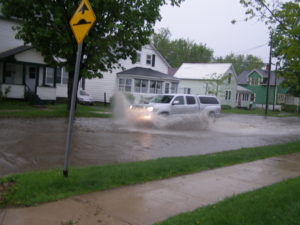Communities and Climate Change
Most NB communities are built on the coasts or rivers. With sea level rise and precipitation changes, our communities will need to prepare for future problems.
What may happen
What are the predicted impacts for communities in a changing climate?
- Changes in river flows, precipitation amounts and a rise in sea levels means that flooding will become more likely in human communities close to rivers and the coast. According to studies by the Geological Survey of Canada, New Brunwick’s coasts are one of two areas of Canada with the highest sensitivity to sea level rise (along with the Beaufort Sea coast) and our rivers are amongst the most highly vulnerable in Canada to climate change.
- The availability of clean drinking water will become a major issue in some areas due to a combination of impacts. More severe storms will result in increased runoff from farms and other developed areas, leading to a potential for increased water pollution and siltation. Extended periods of drought inland can result in lower water tables throughout the province, causing drinking water quantity and quality problems. Higher sea levels may result in increased salt water intrusion into water tables near the coast.
- Areas which are more densely developed, especially city centres, will likely experience higher temperatures due to lack of buffering benefits of vegetation and open water.
- These predicted impacts will influence the safety of existing buildings, roads and railways, and will determine where it will be safe to develop in the future.
- We will be spending a lot more money and effort trying to replace the ecosystem services we now take for granted – like the cooling effects of green spaces and water bodies, the natural flood and erosion control provided by forests and wetlands, and the natural water filtration done by natural areas.
